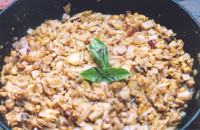
Cooking pasta dishes is my passion, especially in the summer with the fresh garden ingredients.
For best results please follow the instructions step-by-step. Every little detail matters. The ingredients, the timing, the procedures ... there are no short-cuts in good cooking.
The reward is in the end-result.
The brand of pasta that you buy can also make a great difference in the final result. You may know that the cost of pasta is greatly due to the quality of the semolina grain but also to the lengthy process of drying the product before it is packaged. For a lower drying temperature it is required a longer drying time - that makes the equipment much more expensive and raises the cost of the finished product.
The brand Giuseppe Cocco is the best I can find here in Kenosha. www.pastacocco.com
I also recommend to use the organic Celtic Sea Salt both in the water to cook the pasta and in the sauce - click here for more information on the salt.
"Extra-vergine" means that the oil is extracted from the olive fruit without heating (cold pressed). If it does not read "Extra-vergine" (spelling in Italian) don't buy it. Pure olive oil is not good enough.
your dish will be ready in 25 minutes
Heat olive oil in a pan to glaze the onions.
Notice how the onions will turn a translucid color as they cook in the olive oil. The onions are the ingredient that takes the longest to cook in these recipes. Time the other ingredients according to the boiling time of the pasta cut that you have selected.
Picking up the recipe where the onions are 10 minutes into the cooking, add a cup of diced, pitted black olives, two medium sized diced tomatoes (yes, dice the tomatoes with skins and seed - that's all good fiber - you will not choke), 1/4 cup of fresh basil leaves, a chopped shallot and a pinch of Celtic Sea Salt, plus pepper to taste.
Traditionally this recipe calls for a clove of garlic, but I believe that the shallot complements the sweet onions better than the garlic.
Just before the water comes to a strong boil add a pinch of sea salt and bring the flame to the maximum. Check the time on your watch when you drop the pasta in the water. Don't trust the instructions on the box - cooking time always changes depending on the air pressure. After 10 minutes start checking: the pasta changes color as it cooks through. But biting into a piece is the ultimate test "al dente" - the tooth feels the texture to be firm - under-cooking is OK as the pasta keeps cooking when you add the hot sauce.
Drain keeping a small bowl in the sink to collect a little of the starchy water, you may need to add some water back in the dish, if it is too dry. NEVER RINSE the pasta with fresh water.
Add the pasta into the pan where you have cooked the sauce, or put the pasta back into the pot and add the sauce (depending on the proportions and size of your pot and pan). I prefer to add the pasta into the sauce pan, if the quantity of pasta allows.
Final touch: toss the pasta to evenly coat with sauce and add a little olive oil (olio crudo) - uncooked oil. Add cheese, only if you must! I'm not using cheese on pasta any more to accomodate for proper food separation and better digestion. The taste of the veggies is fantastic! Cheese is not necessary and would delay your digestion.

This recipe twist creates a completely different texture and flavor.
When this picture was taken our tomatoes were still green on the vine - with or without tomatoes it's very good.
Above you see the skillet where she cooked the onions with all the ingredients added, except for the basil that we add at the end (here just a couple of leaves for decoration). This pan contains enough sauce to dress 2 pounds of pasta, or the meal of four hungry truck drivers (no offense meant: in Italy "Ristorante per camionisti" means very generous portions).
Visit Giuseppe Cocco's web site to see drawings of each cut.
Troppa grazia Sant'Antonio! My grandpa would say (too many choices Saint Tony), which one should you purchase?
Many times the tradition dictates one cut or an other. But as a rule of thumb you can observe how the thinner, runny sauce calls for a thin cut (typically spaghetti), while a thicker sauce will work best with large cuts, like rigatoni and penne. Conchiglie (shells) are perfect for sauces with peas or other small ingredients that can be scooped into that pasta shape.
But here is the greatest secret: Did you pay attention when I talked about the draining of the pasta, in the section "Add salt and pasta in the boiling water"?
Always remember to collect some of the pasta water (starchy water)! Once you add the sauce to coat the pasta, it may turn out that the pasta cut is not suited for the sauce consistency: Often with spaghetti the sauce is too thick. That's when you reach for the starchy water; add some water into the serving bowl to correct the consistency of the sauce. But keep the secret, and the compliments.
If you know someone that is not receiving our newsletter, click here to sign-them-up.
Looking forward to meet you at the Harbor MarketPlace on market day.
Your friends,
Curzio